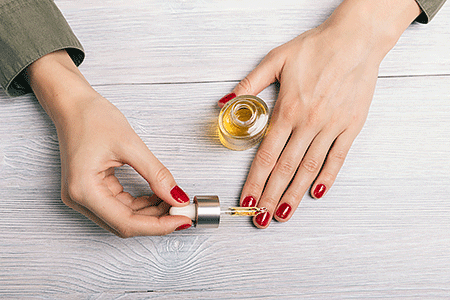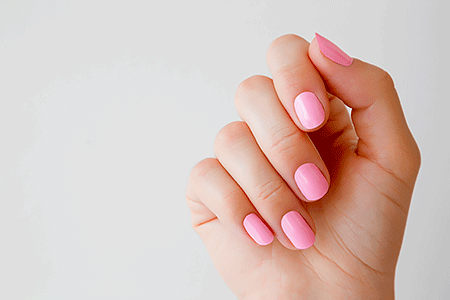Dip powder manicure: 5 tips to keep your nails healthy
Board-certified dermatologist Chris Adigun, MD, FAAD, recommends durable manicures like the one that you can get from dip powder nails for some of her patients. This hard-as-nails manicure can help a patient stop biting or picking at their nails. You literally cannot bite or pick off this nail color. It’s just that durable.
Dip powder nails are also long lasting. When you get a dip powder manicure, you can have chip-free nails for up to four weeks.
The downside is that a dip powder manicure can be tough on your nails.
To help you keep your nails healthy, we asked two board-certified dermatologists to share their tips for how to safely get dip powder nails.
Here’s what they recommend:
Leave your cuticles alone.
When you or your nail technician cuts (or pushes back) your cuticles, this can lead to a serious infection.
To protect your health: Ask your nail technician to leave your cuticles alone. This will reduce your risk of developing a nail infection.
At first, your nail tech may object. Remain firm. No pushing or cutting your cuticles.If you have rough or scaly cuticles, dermatologists recommend that you moisturize them.
Applying petroleum jelly at bedtime is a budget-friendly way to soften rough, dry cuticles. Using cuticle oil is another option that works well.

Skip the “double dip.”
When you get dip powder nails, you usually place each finger into various containers of powder. The base coat, color, and top coat all come in powder form.
When you dip your nails into a container that other people have dipped their fingers into, you are double dipping. If someone who had a nail infection or wart already dipped their fingers into these containers, you can pick up these germs. This could lead to a serious nail infection or wart.To keep your nails healthy, never dip your nails into a container that someone else has dipped their nails into.
This is known as double dipping, which can spread bacteria and other germs from one person to another.

To protect your health: Before getting dip powder nails, ask your nail technician how the powders will be applied.
To reduce your risk of infection, your nail technician must use one of these methods:- Pour each powder from its original container into a disposable container and then throw away any unused powder.
- Sprinkle the powder from the original containers onto your nails.
Get one dip nail your first time.
Some people develop an allergic reaction to the dip nail products. Adhesives, which are used to hold the powders in place, are the main culprit.
“An allergic reaction may occur hours to days after your manicure,” says board-certified dermatologist Shari Lipner, MD, PhD. When a dip nail causes an allergic reaction, you may develop one or more of the following:- Swelling, itching, or discolored skin around the nail
- Fluid-filled bumps on the skin around the nail
- Nail lifts up
To protect your health: Drs. Adigun and Lipner see patients who have developed an allergic reaction after getting dip nails. To protect your health, they recommend that you apply the powders to just one nail at first.
If you go to a nail salon, ask your nail tech to do just one dip nail. You can get regular nail polish on the rest of your nails. Then wait 7 days.
What you do next depends on what happens. Here are the possibilities:
- No skin reaction after 7 days: Go ahead, get a dip powder manicure on the rest of your nails.
- Skin reaction within 7 days: Remove the color from your dip powder nail ASAP and give your skin time to heal. You can get another type of manicure after your skin heals but avoid dip nails. If you need to remove the color at home, follow the same steps that Dr. Lipner recommends for removing gel nail polish at home.
- Skin reaction lingers for 2 to 4 weeks: Make an appointment to see a board-certified dermatologist.
Give your nails time to recover after each dip powder manicure.
Dr. Lipner says, “It’s not dangerous to apply a dip powder every month. However, to remove these manicures, you need to put 100% acetone on your nails, which can damage your nails.”
The acetone removes more than the nail color. “It peels off layers of nail and thins the nails over time,” says Dr. Lipner. “The acetone can also irritate the surrounding skin,” she adds.
To protect your health: If you like gel or dip powder manicures, Dr. Lipner recommends, “After removing the color, wait one month before getting another one of these manicures.”
This doesn’t mean you have to skip all manicures for a month. “If you like nail color, it’s okay to wear regular nail polish,” says Dr. Lipner.Some people develop an allergic reaction to the adhesives used in dip nails.
“If your skin is still reacting after two to four weeks, it’s time to see a dermatologist,” says Dr. Adigun.

Look at your bare nails between manicures.
If you like having color on your nails most of (or all) the time, that’s okay. Just be sure to check your nails for changes each time the color comes off.
To protect your health: Dr. Adigun says, “Looking closely at your nails after removing the color helps you spot a problem early.” That’s important. Most nail problems will heal on their own — or are treatable — when caught early.
“If you see a nail technician for manicures, pay attention while your technician removes the color,” says Dr. Adigun.
While your nails are bare, look for the following:- Nail lifting up
- Skin around one or more nails looks swollen or discolored
- Thickening nail
- Discolored nail
- Any change to the skin around a nail, to the nail, or the skin under a nail
If you see a change to your nail or the skin around a nail after removing the color, skip the rest of your manicure.
Caught early, many nail problems can heal on their own or be treated.

If you see any change, Dr. Adigun recommends that you:
- Remove all nail color and leave your nails bare for 2 to 4 weeks. Many nail problems clear up or begin to grow out within this time.
- If you still have a nail problem after 4 weeks, see a board-certified dermatologist. Board-certified dermatologists specialize in diagnosing and treating conditions that affect the skin, hair, and nails. They have the expertise to tell you what’s happening to your nail and what can help.
Healthy habits can lead to a lifetime of healthy nails
“Most people can safely wear dip powder nails without experiencing a problem,” says Dr. Adigun. By following these five tips, you minimize the risk of developing a problem. Should a problem arise, you know what to do to keep your nails healthy.
Related AAD resources
Images
Getty Images
Written by:
Paula Ludmann, MS
Reviewed by:
Hassan I. Galadari, MD, FAAD
Laurel Geraghty, MD, FAAD
Carrie L. Kovarik, MD, FAAD
Last updated: 7/20/21
 Atopic dermatitis: More FDA-approved treatments
Atopic dermatitis: More FDA-approved treatments
 Biosimilars: 14 FAQs
Biosimilars: 14 FAQs
 How to trim your nails
How to trim your nails
 Relieve uncontrollably itchy skin
Relieve uncontrollably itchy skin
 Fade dark spots
Fade dark spots
 Untreatable razor bumps or acne?
Untreatable razor bumps or acne?
 Tattoo removal
Tattoo removal
 Scar treatment
Scar treatment
 Free materials to help raise skin cancer awareness
Free materials to help raise skin cancer awareness
 Dermatologist-approved lesson plans, activities you can use
Dermatologist-approved lesson plans, activities you can use
 Find a Dermatologist
Find a Dermatologist
 What is a dermatologist?
What is a dermatologist?



